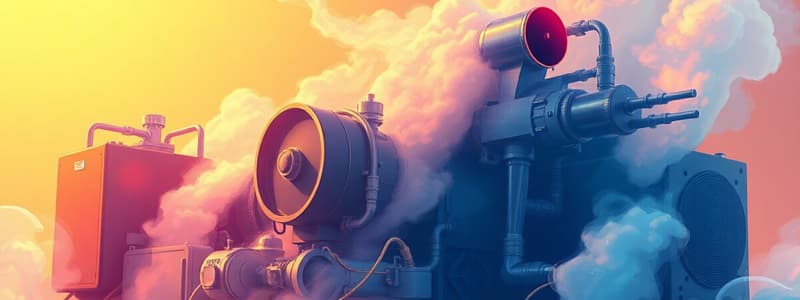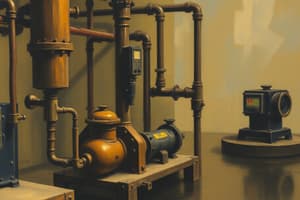Podcast
Questions and Answers
Why is compressed air considered an essential utility in modern industrial facilities?
Why is compressed air considered an essential utility in modern industrial facilities?
- Regulations mandate its use.
- Its use has expanded across nearly all branches of industry. (correct)
- It is the safest and most cost-effective utility available.
- It is primarily used for heating purposes.
In terms of the use of utilities, what is compressed air commonly referred to within the industry?
In terms of the use of utilities, what is compressed air commonly referred to within the industry?
- The secondary coolant
- The primary energy source
- The fourth utility (correct)
- The gaseous power source
What is the main function of an air receiver in a compressed air system?
What is the main function of an air receiver in a compressed air system?
- To heat the compressed air.
- To act as a surge tank and dampen air pulsation. (correct)
- To regulate the speed of the compressor.
- To measure the moisture content of the air.
What is the function of the 'primary receiver' in relation to the air compression unit?
What is the function of the 'primary receiver' in relation to the air compression unit?
What is the distinguishing characteristic of a 'secondary receiver' in an air compression system?
What is the distinguishing characteristic of a 'secondary receiver' in an air compression system?
What is the main purpose of an air compressor?
What is the main purpose of an air compressor?
What principle does an air compressor use to convert power into a usable form?
What principle does an air compressor use to convert power into a usable form?
What characterizes a 'positive displacement' type of air compressor?
What characterizes a 'positive displacement' type of air compressor?
Which category of air compressors is best suited for applications requiring lower pressures?
Which category of air compressors is best suited for applications requiring lower pressures?
What does the term 'staging' refer to in the context of air compressors?
What does the term 'staging' refer to in the context of air compressors?
What is the function of inter-stage coolers in a multi-stage air compressor system?
What is the function of inter-stage coolers in a multi-stage air compressor system?
What characterizes a reciprocating piston compressor?
What characterizes a reciprocating piston compressor?
In a reciprocating compressor, the assembly with valves controls what?
In a reciprocating compressor, the assembly with valves controls what?
What feature makes rotary compressors particularly efficient??
What feature makes rotary compressors particularly efficient??
What is a key characteristic of the rotary-lobe compressor?
What is a key characteristic of the rotary-lobe compressor?
Which systems benefit most from the medium- to high-pressure capabilities of sliding vane rotary compressors?
Which systems benefit most from the medium- to high-pressure capabilities of sliding vane rotary compressors?
What necessity is caused by the injection of oil in screw type rotary compressors?
What necessity is caused by the injection of oil in screw type rotary compressors?
For what purpose are centrifugal compressors and multiple stage axial flow compressors used?
For what purpose are centrifugal compressors and multiple stage axial flow compressors used?
In a centrifugal compressor, what is the role of the impeller wheel?
In a centrifugal compressor, what is the role of the impeller wheel?
What operational aspect significantly impacts collection efficiency in cyclone separators?
What operational aspect significantly impacts collection efficiency in cyclone separators?
What is the upper limit of particle size that increased entry velocity in a cyclone separator can efficiently collect?
What is the upper limit of particle size that increased entry velocity in a cyclone separator can efficiently collect?
In a bag filter system, what does the 'air-to-fabric ratio' measure?
In a bag filter system, what does the 'air-to-fabric ratio' measure?
What type of gas should be used in pneumatic conveying systems when handling potentially explosive materials?
What type of gas should be used in pneumatic conveying systems when handling potentially explosive materials?
What is the crucial role of the prime mover in a pneumatic conveying system?
What is the crucial role of the prime mover in a pneumatic conveying system?
In a pneumatic conveying system, what is the primary function of the 'feeding, mixing, and acceleration zone'?
In a pneumatic conveying system, what is the primary function of the 'feeding, mixing, and acceleration zone'?
Flashcards
Air's role in industry?
Air's role in industry?
Air is crucial in the process industry.
Compressed air is also called?
Compressed air is also called?
Industry's fourth utility is compressed air.
What equipment creates compressed air?
What equipment creates compressed air?
Air receivers and air compressors.
What are the uses of compressed Air?
What are the uses of compressed Air?
Signup and view all the flashcards
Chemical Formula of Air?
Chemical Formula of Air?
Signup and view all the flashcards
Molecular weight of Air?
Molecular weight of Air?
Signup and view all the flashcards
What is Standard Heat Ratio of Air?
What is Standard Heat Ratio of Air?
Signup and view all the flashcards
Critical pressure of air?
Critical pressure of air?
Signup and view all the flashcards
Critical temperature of air?
Critical temperature of air?
Signup and view all the flashcards
What is an air receiver?
What is an air receiver?
Signup and view all the flashcards
What does a surge tank do?
What does a surge tank do?
Signup and view all the flashcards
What is the use of an air receiver?
What is the use of an air receiver?
Signup and view all the flashcards
What is the job of an air receiver?
What is the job of an air receiver?
Signup and view all the flashcards
What is an Air Compressor?
What is an Air Compressor?
Signup and view all the flashcards
What is an Air Compressor a form of?
What is an Air Compressor a form of?
Signup and view all the flashcards
Inlet pressure level can be?
Inlet pressure level can be?
Signup and view all the flashcards
Discharge pressure ranges from?
Discharge pressure ranges from?
Signup and view all the flashcards
What kind of fluid can be compressed?
What kind of fluid can be compressed?
Signup and view all the flashcards
Where can compressed gas applications be found?
Where can compressed gas applications be found?
Signup and view all the flashcards
Types of Displacement?
Types of Displacement?
Signup and view all the flashcards
What is staging?
What is staging?
Signup and view all the flashcards
Types of Positive Displacement Compressors?
Types of Positive Displacement Compressors?
Signup and view all the flashcards
Types of Dynamic Compressors?
Types of Dynamic Compressors?
Signup and view all the flashcards
How do Centrifugal compressors use energy
How do Centrifugal compressors use energy
Signup and view all the flashcards
What are separators?
What are separators?
Signup and view all the flashcards
Study Notes
- Air is a critical utility in the process industry.
- Air compressors are essential in modern industrial facilities due to the widespread use of compressed air.
Compressed Air
- Often referred to as the industry's fourth utility.
- Compressing air involves reducing the volume a given mass of air occupies.
- Equipment needed includes air receivers and air compressors.
Uses of Compressed Air
- Cement industry for clinker cleaning
- Spraying and atomizing
- Pressure filtration
- Drying of granular materials
- Classification of solids
- Palletizing plants
- Combustion reactors
- Operating molds in the rubber industry
- Casting industry
Properties of Air
- Chemical formula: Mixture of N₂ and O₂
- Molecular weight: 28.97
- Specific heat ratio (γ) at 15.55 °C: 1.40
- Critical pressure (absolute): 37.7 bar
- Critical temperature (absolute): 132.8K
- Mean specific heat (C’pm):
- At 0 °C: 29.05 kJ/kmol.K
- At 10 °C: 29.32 kJ/kmol.K
- Air Composition: Approximately 78% Nitrogen, 21% Oxygen, and 1% other gases and impurities.
Air Receivers
- A small tank installed after the compressor.
- Functions include surge tank to dampen air pulsation, cooler, air storage, and removal of oil/moisture.
- Types: Vertical and horizontal models.
- Primary location is near the compression unit, before filtration and drying equipment.
- Secondary location is close to intermittent air consumption points.
Air Compressors
- Increases the pressure of a compressible fluid.
- Converts power to kinetic energy by compressing and pressurizing air for release.
- Inlet pressure can range from a deep vacuum to high positive pressure.
- Discharge pressure can range from sub-atmospheric to high values.
- Inlet and outlet pressures depend on compression type and configuration.
- Can compress any compressible fluid (gas or vapor).
- Applications include consumer products like refrigerators.
Air Compressor - Classification
- Type of displacement: Positive (high pressures) and Non-positive (lower pressures)
- Staging: Based on the number of compression steps.
- Type of drive system: Classified by prime mover (often electric motors)
- Operating Pressure: Low (<151), Medium (151-1000), High (>1000)
- Capacity: Air volume compressed (CFM).
Main Components in Compressed Air Systems
- Intake air filters
- Inter-stage coolers
- After coolers
- Air dryers
- Moisture drain traps
- Receivers
- Distribution system
Types of Compressors
- Positive Displacement: Rotary (Lobe, Screw, Scroll, Liquid Ring, Vane) and Reciprocating (Diaphragm, Double Acting, Single Acting)
- Dynamic: Centrifugal, Axial
Positive Displacement Compressors
- Includes Reciprocating Piston Compressors.
- Reciprocating Piston Compressors: Use pistons and valves to control flow and can be single or multistage.
Reciprocating Compressors
- Used for air and refrigerant compression.
- Cylinder volume reduces with pulsating output, similar to bicycle pumps.
- Single or double-acting configurations are available.
- The most widely used machine for high-pressure air in pneumatic conveying systems.
- Potentially have the best thermodynamic efficiency of air movers.
Rotary Compressors
- Volume of the area is reduced and fluid is compressed as the roller rotates.
- High-pressure fluid forces the exhaust valve to open when exposed.
- Very efficient because fluid intake and compression occur simultaneously.
Rotary Compressor – Lobe-type
- Incorporates two intermeshing rotors on parallel shafts.
- Twin-lobe compressors have two lobes per rotor (four total); tri-lobe have three lobes per rotor (six total).
- Rotors rotate in opposite directions.
- As each rotor passes the blower inlet, it traps a definite gas volume and carries it around the case to the blower outlet while maintaining constant speed.
- Operation allows definite clearances without lubrication inside the air casing.
- Used for low-pressure applications.
Rotary Compressor – Sliding vane-type
- Well-suited for medium to high-pressure.
- Single-rotor device with rotor eccentric to the casing.
- Air delivered without marked pulsation, as compression occurs inside the machine
Rotary Compressor – Screw type
- High efficiency and high capacity
- Require oil injection to reduce internal air leakage.
- Used to cool air during compression, but the oil needs to be removed from the compressed air.
- Consists of intermeshing rotors mounted on a parallel shaft
Non-Positive Displacement or Dynamic Compressors
- Includes Centrifugal and Axial Compressors.
- Centrifugal and multiple-stage axial compressors operate with very high volumetric flow rates.
Dynamic – Centrifugal Compressors
- Use an impeller wheel's rotating action to exert centrifugal force on air inside the volute.
- Fluid is sucked into the impeller through a large circular intake and flows between the impeller.
- Low ratio of compressive force is generated by an impeller wheel.
- Due to such low ratios, centrifugal compressors usually employ more than one impeller wheel arranged in series to increase effectiveness.
- Suited for compressing large fluid volumes to relatively low pressure.
Cyclone Separators
- Forces disengage solid particles from the conveying gas by imparting spinning motion.
- Incoming stream migrates outward and downward due to centrifugal and gravitational forces.
- Collection efficiency depends on particle/air density difference, solid concentration, and cyclone dimensions.
- Increased entry velocity increases collection efficiency up to a 10-micron particle size limit.
- Tangential introduction of gas affects rotation.
- Solid dust particles collect at the base while clean gas exits at the top.
Bag Filters
- Universally used filtration method.
- Used as bin vents where solid material is blown into the hopper and clean air is vented off through a filtering unit.
- Collected material typically discharges from the base.
- Suitable for continuous and batch conveying operations.
- Measure filter size by the air-to-fabric ratio (volumetric air flow rate / effective filter fabric area).
- Have dimensions of velocity.
- Power required to use bag filters is low due to lower volumetric flow rate of operation.
Pneumatic Conveying System
- Suitable for the transportation of powdered and granular materials.
- Typically uses air.
- Other gases are used when special considerations exist such as risk of explosion or health hazards.
- Systems are enclosed entirely.
- Dry air can be used for hygroscopic material. Inert gases (like nitrogen) can be used for potentially explosive materials.
- Zones consist of:
- Prime mover
- Feeding, mixing, and accelerating zone
- Conveying zone
- Gas and solid separation zone.
Pneumatic Conveying System Zones
- Prime mover: Provides necessary energy for gas conveyance; includes compressor, fan, or blower.
- Feeding, mixing, acceleration zone: Crucial for introducing solids into the flowing gas. As solids are introduced in the moving gas, momentum change occurs.
- Accelerating Zone: Pipe section designed to allow solids to reach steady-state flow.
- Conveying zone: Piping and piping selection depending upon a number of factors like the abrasiveness of the product, pressure requirement, etc for solids transport. Change in the direction of flow from bends provides acceleration to the solids.
- Gas and solids separation zone: Size of separated solids helps to select what type of gas-solid separator is required.. Different gas-solid separation systems configurations used.
Studying That Suits You
Use AI to generate personalized quizzes and flashcards to suit your learning preferences.




